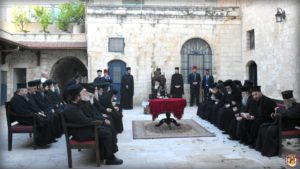FEAST OF SAINTS CONSTANTINE AND HELEN, EQUALS TO THE APOSTLES
An article by: Heba Hrimat
Constantine was the son of Constantios Chloros, the ruler of the westernmost parts of the Roman empire, and his consort, Helen. He was born in the year 272 in Naissus of Dardania, a city on the Hellespont. By the age of 34 his father died and thus Constantine was proclaimed successor to the throne.
Six years later, Constantine learned that Maxentius had joined forces against him, and so he marched into Italy, where, while at the head of his troops, he saw in the sky after midday, beneath the sun, a radiant pillar in the form of a cross with the words: “By this shalt thou conquer.”
The following night, Jesus Christ appeared to him in a dream and declared to him the power of the Cross and its significance. Upon arising in the morning, Constantine immediately ordered that a labarum be made in the form of a cross (labarum: a banner or standard of victory over the enemy), and he inscribed on it the Name of Jesus Christ.
On the morning of October 28, Constantine attacked and conquered Maxentius, who drowned in the Tiber River while fleeing.
The following day, Constantine entered Rome in triumph and was proclaimed Emperor of the West by the Senate, while Licinius, his brother-in-law, ruled in the East. But out of malice, Licinius later persecuted the Christians.
Constantine fought him once and again, and utterly destroyed him in 324, and in this manner, he became monarch over the West and the East. Under him, and because of him, all the persecutions against the Church ceased. Christianity triumphed and was announced the main religion of the Empire and idolatry was overthrown.
In 325 he called the First Ecumenical Council in Nicaea, which he himself personally addressed, to create the Creed that forms the belief system of Christians. In 324, in the ancient city of Byzantium, he laid the foundations of the new capital of his realm, and solemnly dedicated it on May 11, 330, naming it after himself, Constantinople.
Since the throne of imperial rule was transferred to Constantinople from Rome, it was named New Rome, the inhabitants of its domain were called Romans, and it was considered the continuation of the Roman Empire.
Saint Constantine died on May 21 or 22 in the year 337, having lived sixty-five years, of which he ruled for thirty-one. His remains were transferred to Constantinople and were buried in the Church of the Holy Apostles, which had been built by him.
As for his holy mother Saint Helen, after her son had made the faith of Christ triumphant throughout the Roman Empire, she undertook a personal pilgrimage to Jerusalem and found the Holy Cross on which our Lord was crucified.
After this, Saint Helen, in her zeal to glorify Christ, erected churches in Jerusalem at the sites of the Crucifixion and Resurrection, in Bethlehem at the cave where Christ was born, another on the Mount of Olives where ascension occurred and many others throughout the Holy Land, Cyprus, and elsewhere.
She was proclaimed “Augusta,” her image was stamped upon golden coins, and two cities were named Helenopolis after her, in Bithynia and in Palestine. She died of old age in either in 330, or in 336.
To honor their monumental contribution to the Christian Orthodox faith, the Patriarchate of Jerusalem dedicates a church within its walls in the Old City of Jerusalem, which holds both names of the Saints: the Church of Saints Constantine and Helen; where an annual patriarchal divine liturgy takes place on June 3rd to celebrate their memory.

